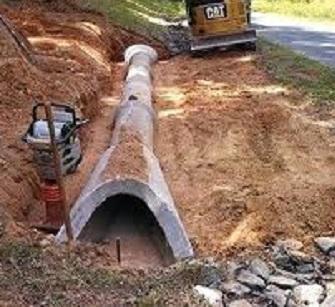Accuracy Pad Construction for Steady Structures
Accuracy Pad Construction for Steady Structures
Blog Article
Culvert Installment Facilitated: Step-by-Step Guide for Success
Setting up culverts might appear like a simple job, however making sure an effective result calls for careful preparation and implementation. From picking the ideal culvert dimension to integrating proper drainage measures, each action in the installment process plays an essential function in the functionality and longevity of the culvert system. By adhering to a systematic method and focusing on crucial details, the installment can continue efficiently, minimizing prospective problems down the line. Remain tuned to uncover the important steps and considerations that can make culvert setup a seamless and successful endeavor.
Picking the Right Culvert Size
Choosing the ideal culvert size is essential for making certain efficient water circulation and architectural integrity in culvert setup tasks - Pad Construction. The size of the culvert directly influences the circulation capability of water via the framework. A culvert that is also tiny can bring about flooding and overflow, while one that is as well big may lead to lowered water velocity, potentially triggering sediment accumulation and obstructions
To determine the best culvert dimension, elements such as the watershed area, peak flow rates, and hydraulic effectiveness need to be carefully thought about. Estimations based on these parameters help in selecting a dimension that can properly take care of the anticipated water quantity while decreasing the risk of obstructions and architectural failing.
It is necessary to get in touch with engineering guidelines and standards to make sure that the selected culvert dimension satisfies the task requirements and regional regulations (Pad Construction). By selecting the ideal culvert dimension, job supervisors can maximize water flow, prevent prospective issues, and boost the overall efficiency and longevity of the culvert installation
Preparing the Setup Website
Reliable culvert installation necessitates meticulous prep work of the installation website to ensure optimum architectural support and functionality. Prior to starting the setup procedure, it is vital to get rid of the website of any kind of debris, vegetation, or blockages that could restrain the culvert's placement. Guaranteeing a degree structure is necessary for the correct alignment and security of the culvert. This may include grading the website to develop a smooth, even surface area that can adequately sustain the weight of the culvert and any kind of awaited lots. In addition, proper compaction of the soil under the culvert is necessary to stop resolving or changing over time.
Moreover, it is essential to take into consideration factors such as dirt composition, groundwater levels, and ecological effects when preparing the setup website. Performing an extensive website evaluation can help recognize any kind of potential difficulties address or risks that might affect the culvert's performance. By putting in the time to prepare the installation website correctly, you can aid assure an effective culvert installment that fulfills architectural requirements and ensures long-lasting functionality.
Positioning the Culvert Appropriately

The quality at which the culvert is put is crucial for preserving a correct slope for water circulation. In addition, the culvert must be oriented properly to guarantee that you can try these out the inlet and electrical outlet are in the correct locations. Pad Construction.
Backfilling and Compacting the Soil
Proper backfilling and compaction of the soil around the culvert is necessary to make sure stability and avoid possible issues in the future. Once the culvert is correctly positioned, the next essential action is to backfill the location around it with ideal product. The backfill material must be totally free from rocks, debris, and raw material to prevent damage to the culvert. It is suggested to utilize granular material such as sand or gravel for backfilling, as it provides excellent drainage and compaction buildings.
After putting the backfill material, it is necessary to portable it in layers of uniform density. Making use of a compactor or a mechanical meddle, small the soil carefully to stay clear of damaging the culvert. Compaction helps in decreasing the opportunities of negotiation and makes sure consistent assistance around the culvert. It is vital to small the soil equally on all sides of the culvert to keep its architectural integrity.
Correct backfilling and compaction not only provide stability to the culvert but likewise assist in stopping soil erosion and preserving the longevity of the culvert system.
Guaranteeing Appropriate Water Drainage Combination
Integrating efficient drain options plays a critical read role in the overall capability and durability of culvert setups. Correct drainage integration is essential for managing water flow, avoiding erosion, and guaranteeing the architectural integrity of the culvert system. To accomplish this, it is important to design an extensive water drainage plan that takes into consideration variables such as the volume of water anticipated, the topography of the location, and the sort of soil present.

Furthermore, integrating functions like disintegration control actions, such as riprap or plant life, can even more improve the effectiveness of the water drainage system. By thoroughly preparing and executing these water drainage options, culvert setups can function efficiently and endure the test of time.
Final Thought
Finally, appropriate culvert installation is essential for maintaining reliable drainage systems. By picking the right culvert dimension, preparing the setup website, placing the culvert correctly, backfilling and condensing the soil, and ensuring appropriate drainage combination, success can be attained. Complying with these steps will aid guarantee the durability and effectiveness of the culvert, inevitably adding to the overall success of the drain system.
Report this page